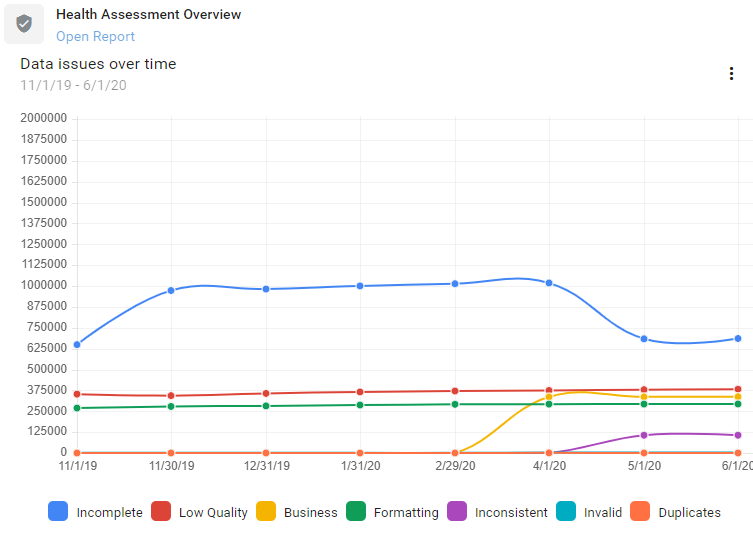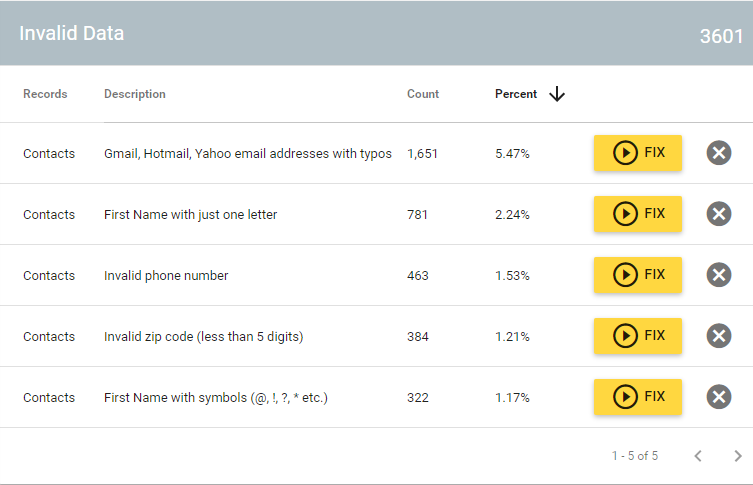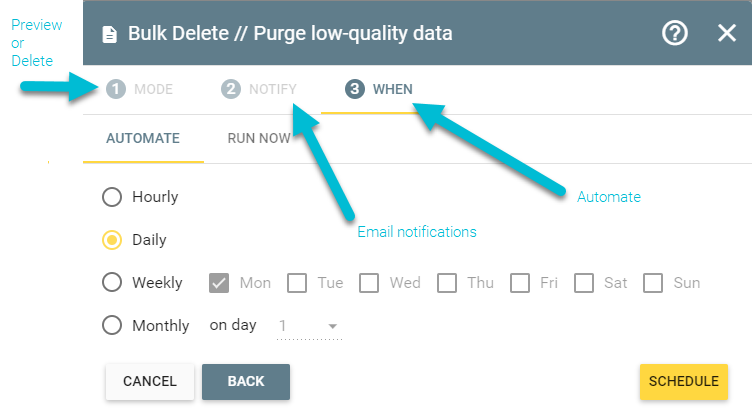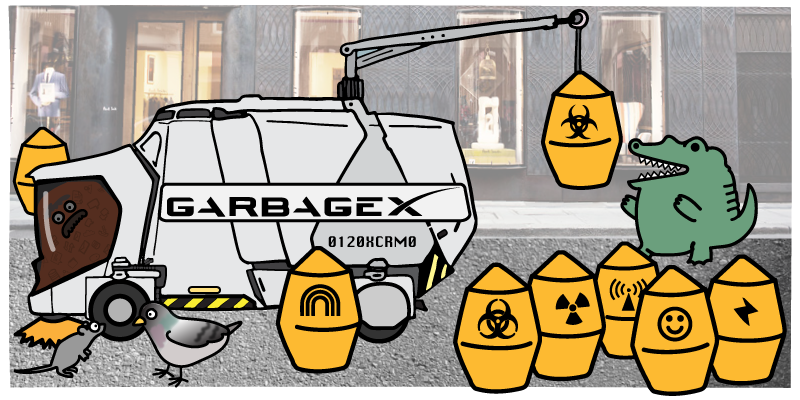Purging data on a regular basis plays a critical role in CRM database maintenance.
Allowing low-quality and problematic data to remain in your database causes many problems. It can balloon your CRM costs in plans that are based on the number of contacts. Low-quality contacts lower email open rates and harm your sender reputation. Clutter makes it difficult for all teams that rely on customer data to filter, analyze, and utilize the data that you collect.
Marketing teams will see their marketing efforts hit a roadblock as they try to find ways to personalize at scale while accounting for low-quality data across the database. Sales teams will see their assignments cluttered with low-quality and outdated records, sapping their attention and pulling them in the wrong direction. Data reporting and analysis will be less accurate and more likely to cause poor decision-making.
But purging that data is an ongoing task with many challenges associated with it. First, you have to identify what records that you want to remove. To do this effectively , you need to identify purgeable, low-quality data within your database that currently have no value to your organization.
That’s easier said than done.
Most CRMs do not offer sophisticated filtering to identify unusable email addresses and phone numbers that are clearly not authentic, this often means exporting your data and using advanced Excel functions and VLOOKUP to filter and purge data in bulk, tag in Excel, and then reimport back to the CRM only to delete the bad records.
Additionally, as this is an ongoing challenge, the process of purging data is something that you will have to undertake on a regular basis. That means going through the same steps on a weekly, monthly, or quarterly basis — however often you need to purge data. This manual approach takes valuable time from your day, and the clutter that accumulates between the cleanups affects your teams’ productivity.
In this article, we’ll explain why ongoing data purging is necessary and explore the various categories of data to consider for purging. We’ll also break down how Insycle can help maintain your CRM in neat condition, consistently free of clutter, by automating the process of purging data.
So what are some common reasons you might want to purge data from your CRM?
Why Purging Data is a Necessity For Running Efficient Sales and Marketing
When your teams have confidence in your data, they are more effective at their jobs. Your marketing teams will be able to inject more personalization into their messaging and improve their email marketing campaigns. Sales teams will be less inundated with contact clutter and able to focus on more valuable opportunities. Both teams will have more wiggle rooms in their budgets as a result of lower CRM costs from having fewer contacts in the database.
Different reasons why purging data is necessity for efficient sales and marketing teams include:
Keep CRM Costs Down
Many of the largest CRMs base their pricing structure on the number of contacts in your database. The more contacts you have in your database, the more your costs balloon over time. With the costs of CRM and marketing automation software rapidly rising and companies constantly expanding the amount of data they collect, this quickly becomes a critical concern for many organizations.
Paying a fee based on the number of contacts in your CRM means you must regularly purge low-quality contacts to keep costs down. In some instances, jumping up to a new level could mean thousands of dollars out of your pocket every month.
In these situations, consistently purging low-quality and outdated contacts directly impacts your monthly costs and budgets across departments.
Improve Productivity and Efficiency Across All Teams
A cluttered CRM is an issue across an organization. It impacts everyone’s ability to use and confidence in the data they need to do their jobs.
Marketing teams will see their budgets wasted, sending communications to many contacts without value to your organization. Sales teams will see their efficiency take a hit as reps are assigned low-value prospects that lack context and cannot convert. It also makes finding specific information more difficult. A cluttered CRM leads to inaccurate reports and causes bad decisions organizationally.
Purging bad data or uninterested contacts allows your teams to place more focus on the prospects and customers that have clearly displayed an interest in your products and inject personalization into their communications with confidence.
Increase Email Open Rates
The open rates of your emails affect the deliverability for your list as a whole. To maintain a positive email reputation, you must always work to improve open rates among your subscribers and customer lists.
Unengaged contacts are another ripe candidate for purging from your database. If a prospect hasn’t opened an email from your company in six months or even a year, does it really serve your company to continue emailing them? Likely not.
Of course, every business is different and the timeframes for when a contact should be considered “unengaged” should depend on a number of different factors. For example, high-ticket B2B companies with enterprise offerings would typically not start purging unengaged contacts after six months, they have longer sales cycles to consider. However, that might be a reasonable timeframe for a B2C eCommerce store.
Removing unengaged contacts from your database will help you improve open rates from your email marketing efforts, improving your email sender reputation and increasing deliverability across all lists and sequences. Regularly purging unengaged contacts improves the ROI of your email marketing across the board.
Categories of Data to Consider for Purging
There are many potential approaches for identifying data that needs to be purged.
When companies look to purge data from their database, it often starts with a specific problem. Maybe your CRM costs balloon due to inflated contacts, or your team is wasting too much time running into issues from disorganized and cluttered CRM data.
But figuring out what records should be removed to solve your problem can be more difficult. You want to ensure that you're setting effective, hard rules for determining which records are purgeable so that they can be deleted in bulk without worry.
There are a few different approaches that you can take to identify records for purging. These include:
Undelivered Emails
Maintaining your sender reputation and the quality of your mailing lists requires that you are able to limit bounced and undelivered emails. The more your emails bounce, the more impact these will have on your sender reputation.
Now, there are some important considerations here. You don’t want to immediately jump to purging contacts with undelivered emails, as there are reasons why the email may bounce on a particular send and still be a valid email that you can use in other campaigns.
For instance, the company’s web host may use an email analysis and filtering solution that detects that a particular send could be spam and rejects (bounces) it. That email is never delivered and will appear as bounced in your marketing automation software.
These are what is known as “soft bounces,” which include any non-permanent reason why an email might bounce. Other reasons for soft bounces on emails include:
- The recipient’s mailbox is full (over quota).
- Their mailbox is not configured correctly.
- The email server is down or offline.
- The email server has received too many requests in a period of time.
- The email message is too large.
- The email message blocked due to content.
- The email message does not meet the recipient server’s policies, such as DMARC, anti-spam, or anti-virus requirements.
- The email cannot be relayed between email servers.
These are non-permanent reasons and may not be indicative of a problem with the contact. However, an email that soft bounces several times in a row can be a sign of deeper problems with the contact. If you want to purge emails that have soft bounced, that variable should be combined with others to help determine whether or not a contact is low-quality.
Mostly, we only want to purge emails that hard bounce due to a permanent reason such as an email address no longer existing — like if the contact left the company — or if emails had been permanently blocked.
Invalid Form Inputs and Clearly Fake Data
Records with invalid data are a good place to start when it comes to purging records from your database. Invalid data can take many forms, and without proper form validation, a lot of low-quality and invalid data can slip through the cracks.
Some examples of invalid data from form inputs can include things like throwaway emails or generally inaccurate information, often shared with a company to take a peek behind a login or gain access to a piece of content, without having to provide their real information. They may be uninterested contacts who just want to “test things out.” Additionally, invalid form input data can indicate automated bots sending data through your forms. For example, phone numbers with all zeros or other repeating digits, first name or email using “test”, “fake”, or “asdf” which is a convenient sequence of letters to use just to get past a form entry.
Records that contain a lot of invalid data can be the perfect place to start when you are looking to purge records from your database, as they will never pan out into paying customers and instead only serve to increase your costs and make your data disorganized and inaccurate.
Low-Quality Data
Removing low-quality data is the low-hanging fruit when it comes to keeping your sales and marketing teams efficient. When data is low enough in quality to the point of being unusable, it does you no good to leave it in your CRM.
But what does “low quality” mean? In your CRM, there are many traits that can signify low-quality data and make them candidates for purging. These include things like contacts with “noreply” email addresses, records with invalid and obviously fake form inputs, group and company email addresses, unengaged contacts, and data with errors.
Low-quality data impedes your ability to provide customers a high-quality, positive experience. Sometimes, it can harm your brand reputation — such as when you personalize communications with outdated or inaccurate data. Low-quality records should be removed from your database as quickly as possible to limit their negative impact.
Outdated and Decayed Records
Although customer and prospect data might be accurate when it first hits your database, it will not remain so over any length of time.
This is particularly true in B2B. Your prospects and customers will receive promotions. They’ll accept positions at new companies. Their phone numbers and email addresses will change. While B2C records become outdated at a slower rate, they too reduce in quality and accuracy over time. 40% of email users change their email address at least once every two years. 21% of all CEOs change every year.
This is known as ‘data decay,’ which describes the rate at which accurate data loses its accuracy over time. US companies have an average annual turnover rate of 22%. With that in mind, you can expect that somewhere around 22% of all of the records in your average B2B database are no longer accurate after one year.
While investing in data enrichment might allow you to update an older phone number or job title, you’ll always struggle to fix older, outdated records when your customers and prospects move to new companies. Losing weeks of your sales process to targeting contacts that are no longer with a company can make or break your ability to close a sale.
Outdated records will have a negative impact across your organization. Marketing teams will struggle with personalization for those records and will suffer from increased bounce rates on email marketing campaigns. Sales teams will lose confidence in your data and have to add manual checking processes to ensure that the data they use in their sales conversations are accurate.
Removing old, outdated records will help you streamline your work processes in multiple departments, refocus on newer accounts with more potential, and create confidence in the data your teams use to do their jobs effectively.
“Lost” and Unqualified Prospects
When a prospect goes through your marketing nurturing processes and full sales cycle, only to not become a customer, it may make sense for you to remove them from your CRM entirely. These contacts often end up cluttering your CRM and sales rep assignments as unqualified prospects with no real path to conversion available.
By purging them, you remove unqualified records from sales rep assignments and to-do lists. Removing “lost” prospects will allow your sales teams to focus on newer, higher-potential opportunities.
Bad Records From Third-Party Integrations
In most companies, the data contained within your CRM will be a mix from different sources including integrations and imports from third-party sources.
There are many issues that can crop up from third-party integrations. They might create duplicate contacts. The fields might not match between the two, leading to lost or disorganized data. The data contained within those records might use different formats or cause standardization issues throughout your database. Or, there might just be data corruption errors that lead to the data being scrambled and unusable.
Dealing with this typically means deleting the old data from your database. You could export and clean the selected records using complicated Excel formulas before re-importing them or clean them one by one within your CRM software.
Either way, you have to make sure that you remove bad records from a third-party integration as quickly as possible, particularly if they will be immediately enrolled in marketing or sales campaigns.
Incomplete Contact Data
Records with incomplete data are often a good choice when purging low-quality records from your CRM. Records with many incomplete or missing data fields provide no value to your teams and only make your database cluttered and disorganized. You can’t personalize a message with missing data. But you only want to purge records with incomplete data when it is completely useless, so you have to combine the identification of these records with other rules from this list before purging.
Identifying records that are missing critical information that you will need to engage with those contacts — such as phone numbers, email addresses, and names — are great candidates to be purged. Records containing a combination of missing or incomplete fields are unlikely to provide any positive impact in your system.
Free and Group Email Addresses
The email address provided can be an easy way to gauge the overall quality of a particular contact.
For instance, email addresses from free email providers like Gmail, Hotmail, or Outlook can signify a low-quality contact for B2B companies.
Additionally, “group” email addresses for companies — like info@acme.com or sales@amce.com — can be considered low-quality as well, as they are unlikely to yield conversations with the right prospects and typically result in much lower open and reply rates.
Records with free and group email addresses are good candidates for purging when combined with other rules. For example, if they have a free email address and are missing data in one or more critical fields, and haven’t engaged with your emails in the last year, these may be good candidates for purging.
Removing contacts with free and group email addresses will help to make your database less cluttered while improving open and reply rates for your email campaigns.
Unengaged Contacts
Continually sending emails to subscribers that do not engage with them can drag down your sender reputation, annoy subscribers that have clearly shown they are not interested, and increase costs for your CRM and marketing automation software.
There are many different variables that you could take into account when filtering contacts and labeling them as “unengaged.” You can also combine multiple variables, including:
- Time since email open
- Time since link clicks
- Time since reply or conversation
- Time since last product usage
- Time since last website visit
- Time since contact create date
- Unsubscribed
- Complaints and SPAM flags
If a contact hasn’t opened an email in a year or more, there is little chance that they will suddenly become engaged out of nowhere. Rather than having those outdated, unengaged contacts taking up space in your CRM, it is often best to remove them. If they become interested again at a later date, they will fill out a form and re-engage. Until then, their presence in your database will only serve to cause confusion and waste time.
Unqualified Contacts
Another variable that you could use to identify records for purging is unqualified contacts. In every company, this could mean different things and encompass a range of variables.
You have already tried to sell these prospects but were not a good fit for your value proposition. There may come a time when you want to circle back to these leads, but you may want to re-engage with them with a fresh start. Their data and needs can change over time. The record that is currently in your system may not be all that useful down the road.
Another potential way to identify and remove unqualified contacts in your CRM is through company headcounts. If you sell enterprise software, for example, you could safely remove every contact that works at a company with 5 or fewer employees.
Removing clearly unqualified contacts from your system is a quick and easy way to ensure that you don’t waste time and budget on opportunities that will never work out.
Duplicate Contacts
Duplicate CRM data can cause many issues. Duplicate contacts can cause embarrassing mistakes from marketing teams, such as emailing the same prospect multiple times, and make it difficult to personalize communications. Sales teams have to dig into your data to check for duplicates to make sure that they have all of the context that they need for sales conversations. Support teams need to do the same to ensure they can speak to a prospect’s specific problems.
Further, duplicate contact data breaks the single customer view, which is a single source of truth for everything we want to know about a particular contact.
Duplicate records waste your marketing budget. It is not uncommon for companies to have a duplicate rate reach 20% of their total number of records.
Purging duplicates allows your marketing, sales, and support teams to focus on their jobs effectively and avoid adding extra steps to their work processes to check for potential duplicates.
How Insycle Can Automate the Removal of Low-Quality Records
Insycle enables you to purge low-quality data systematically. Instead of chasing over bad data reactively, you can implement a strategic data policy for purging data and schedule it to run automatically.
Highlight of the benefits:
- Sophisticated ways to identify low-quality data.
- Templates to store rules and standardize the process of purging data.
- Safety controls that include “Preview” mode and CSV export as a basic backup.
- Automation to execute reliably without requiring time and effort from your team.
Using Insycle, you can filter data in sophisticated ways to identify low quality data. This includes many out-of-the-box templates and the ability to customize filters for your specific data and custom fields.
The Customer Data Health Assessment is a comprehensive tool for identifying purgeable records. It analyzes your database automatically and identifies issues in your data while tracking their prevalence over time, helping you to uncover records that would be good candidates for purging. You can also build and add custom templates to health assessment to track issues unique to your organization.

You can build advanced templates for identifying purgeable records, using multiple variables to truly drill down into your data and ensure that you only remove records that make sense and meet strict qualifications.
You can use Insycle’s pre-built templates or build your own to solve your unique data problems. Then, those templates can serve as rule sets for standardizing the process of purging your CRM data automatically.

Insycle offers safety controls to ensure you are only deleting records that deliver no value to your organization.
You can preview your purged records before the update is pushed live to your database.
This is ideal for adding a quality control and approval step prior to bulk-deleting contacts from your database. You can also add more fields to the layout for additional context about the to-be-deleted records. Those additional fields will also be included in the deleted records report.
When you are satisfied with the result, you can send yourself a .CSV of the purged data directly to your email, or a coworkers’ email, so you always have a basic backup of the removed data if you need it. You can re-import the records if you realize that you made a mistake.
But purging is never a one-time thing. Whether attempting to keep your costs down, decluttering your database, or getting rid of low-quality data, you will always need to purge data and keep your database clean.
With Insycle, you can schedule regular automatic data purges on a set schedule, using the templates that you build. Each time an automatic purge runs, a .CSV of the removed files will be emailed to your chosen email so that you can evaluate the records and keep an audit trail in place. Automating the CRM data purging process will save your team time and effort.

Automate Data Maintenance to Keep Your CRM Neat
Identifying and purging records from your CRM database is critical for reducing your costs and improving efficiency among your teams. Insycle makes it easy to identify and filter data using advanced rules, then regularly purge low-quality data from your CRM on a set schedule.
Insycle is a complete customer data management solution for cleansing your CRM data, standardizing your fields, and improving efficiency for your marketing and sales teams through smart data automation and collaboration. With Insycle, your team does not have to spend hours every week on mundane data management tasks and can instead focus on their objectives.
Unlike other tools that offer limited ways for identifying low-quality data reliably and require manual steps that can result in accident removal of the wrong records, Insycle lets you preview your data before it is purged. It generates a .CSV of the deleted data so that you have an audit trail. This protects you while giving you a powerful tool for removing low-quality data from your database, across a range of CRM integrations.
Start decluttering your CRM today and purge low-quality records from your database to keep your costs down.






